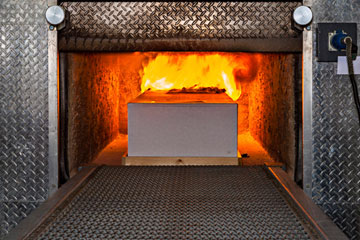
A body in the fire-based crematory oven of Lakewood Cemetery.
(4 of 8)
Once you've been properly ID'd and all the paperwork is in order--which generally includes a permit from the state and authorization by the next of kin--you're placed into the cremation chamber. It's going to get hot, maybe up to 1,800°F (982°C). Let's hope you're not overweight and getting put in at the end of the day, because the whole thing might get too balmy and you could burn down the crematory, and maybe even the funeral home along with it. That's what happened in Austria in April 2012, when the body fat of a 440-lb. (200 kg) woman caught fire, clogged the crematory's air filters and almost destroyed the entire facility. But don't worry. Thanks to the U.S.'s obesity epidemic, a number of new crematories are being built to hold individuals weighing up to 1,000 lb. (454 kg).
After at least an hour of intense heat and flame, you're reduced to grayish ash that will be raked into a box and left to cool. If you've had surgery, there may be a couple of screws or some wire left behind. That is removed. But there's also the problem of your femurs--they didn't burn completely--along with several other bone fragments. Those are put into what is essentially a giant food processor, which pulverizes them with spinning blades. They're joined with your campfire-like ashes, which are then returned to the family. Now your family has to figure out what to do with you.
That's where a guy like Mike Nicodemus comes in. The vice president of cremation operations at Hollomon-Brown Funeral Home & Crematory in the tidewater Virginia area has some options for you. Nicodemus likes to compare his "personalization wall" of urns and cremation merchandise to New York City during the holidays. "You know what the city is like at Christmastime when you walk down Fifth Avenue?" he asks. "People like that, and they say, 'Wow.' That's what we have."
Nicodemus sells wind chimes that hold ashes, laser-etched urns, baseball-themed urns, biodegradable urns, artificial reefs, military-themed merchandise and much more. And business is good. "In 1998, we were at 20% cremations," says Nicodemus, "and I predict by the end of the year we'll be at 60%. We knew it was coming. It just came a little bit quicker than anticipated. But we embraced it."
A past president of CANA, Nicodemus says he's seen a generational shift in the way Americans approach death. Baby boomers, who are just now reaching the age when they have to confront end-of-life issues, didn't live the way their parents did, and they're not going to go through death the way their parents did.
They're redefining death thanks to a more basic reason: they're the most mobile generation in history. Boomers are more likely to have been college-educated, to have found a job, to have started a family, to have retired and to die all in different places. So where are you supposed to be buried after a life like that? Because fewer of us live and die in the same place, we often lose touch with our birthplace, where most would normally get buried. That's one reason why cremation rates along the edges of the U.S. are higher than in the middle of the country. More people leave Kansas for Seattle than the other way around--and when those Seattle transplants die, where their bodies go gets complicated quickly. Sending your remains to rest eternally in Kansas becomes much easier inside an urn.
